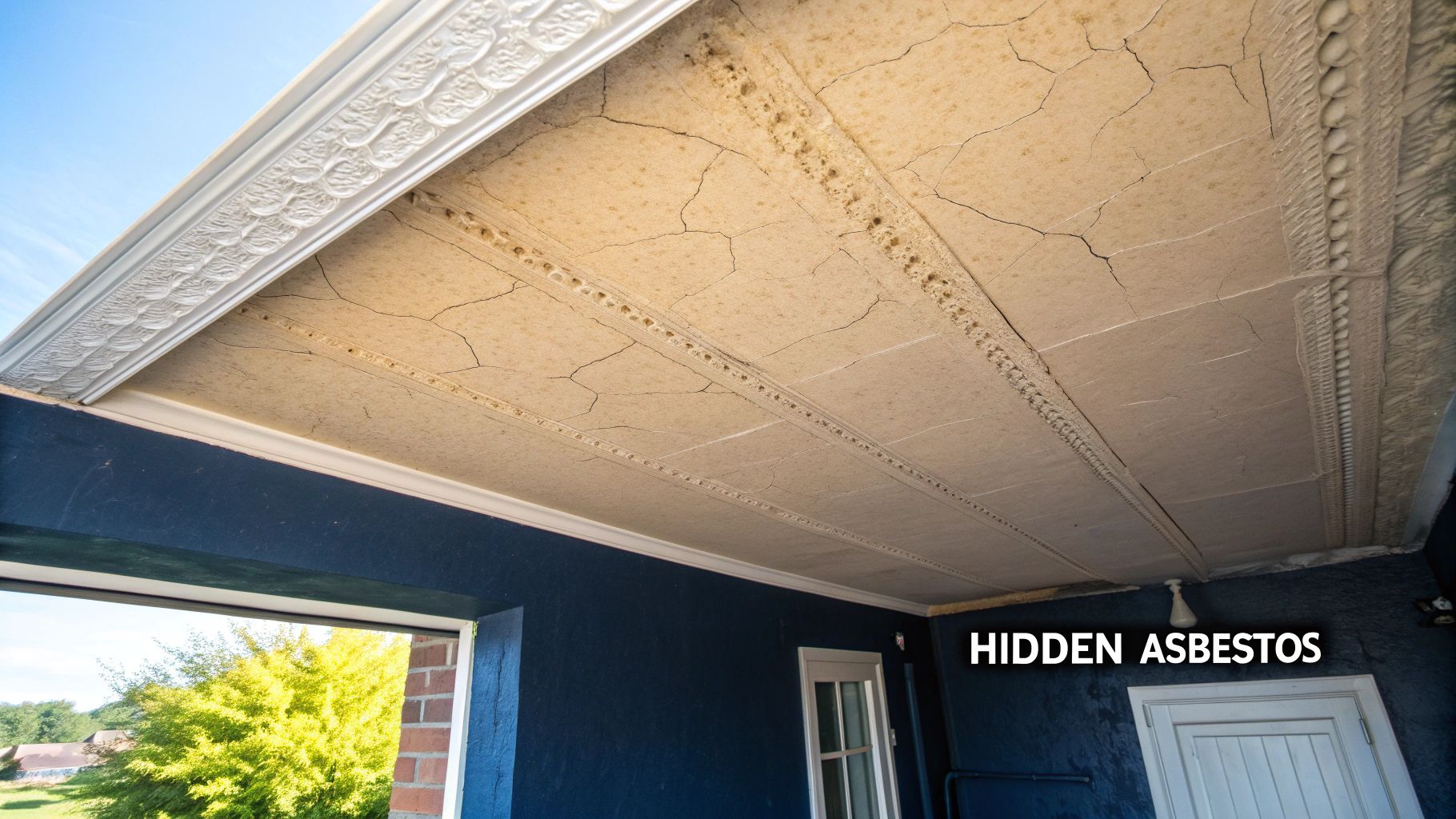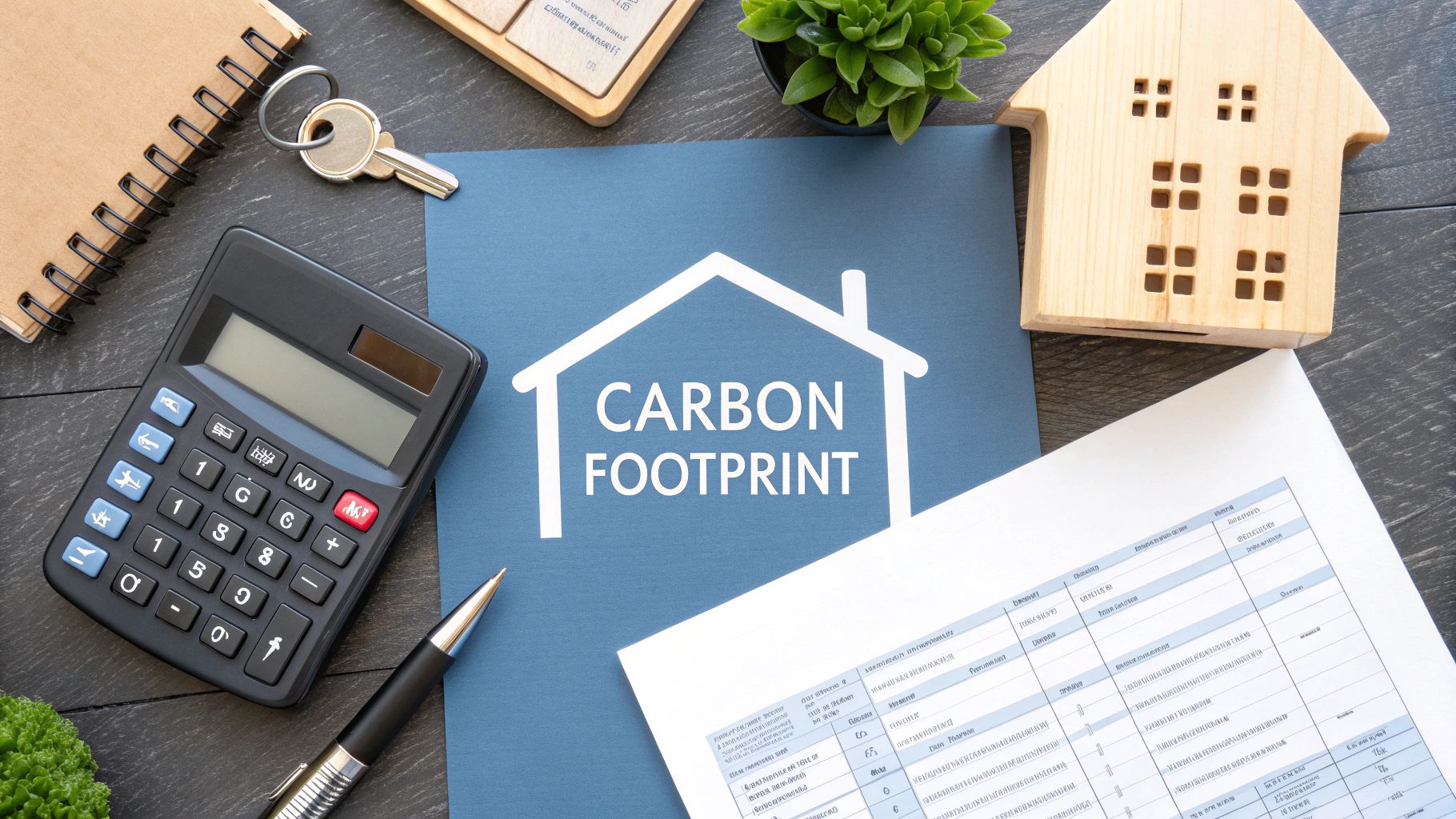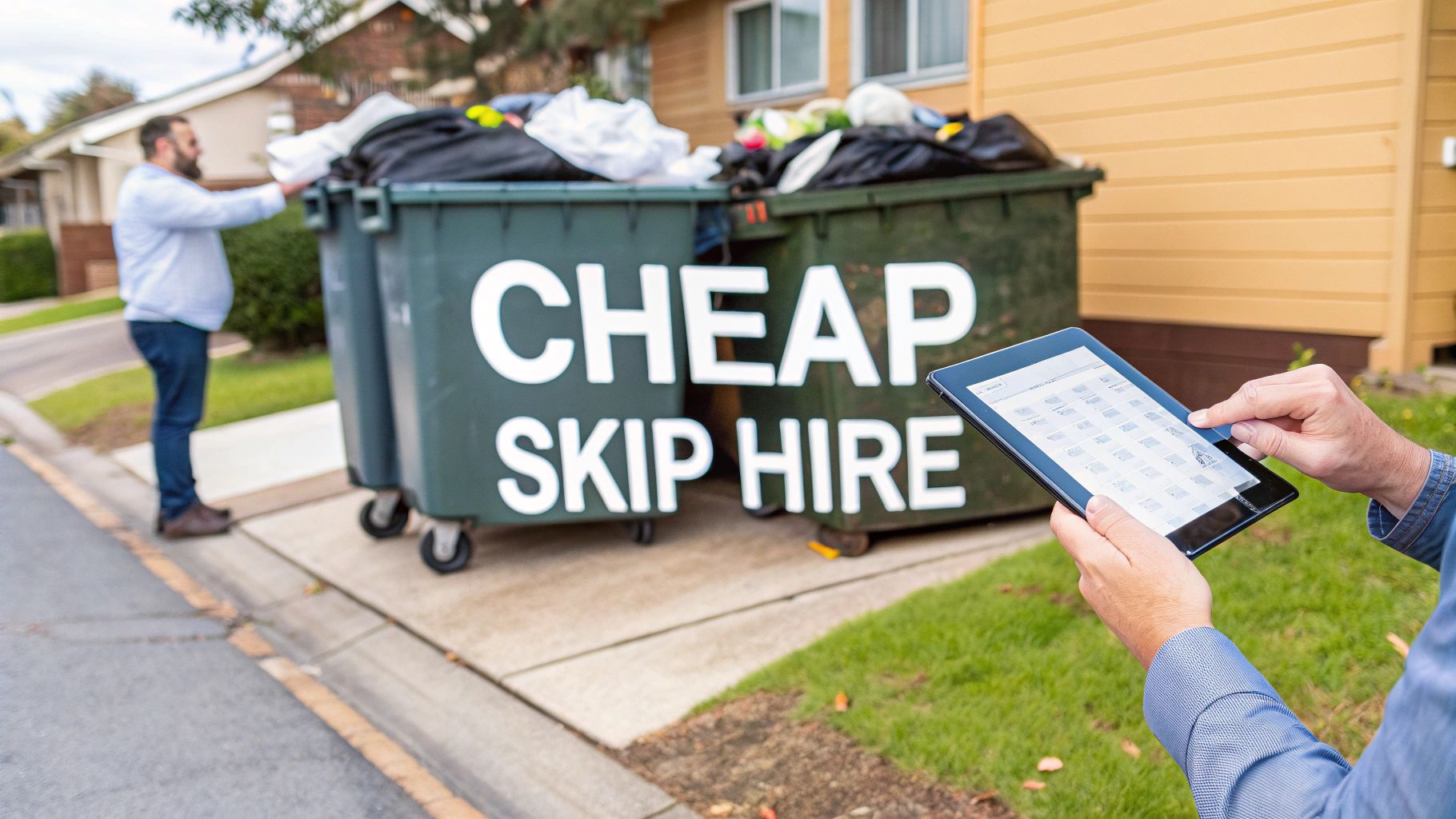Removal of asbestos ceilings: A Homeowner’s Guide
Removal of asbestos ceilings: A Homeowner’s Guide
Removing an asbestos ceiling is a highly specialised and dangerous job. It absolutely must be handled by licensed professionals to prevent the release of deadly fibres. If you even suspect that your textured ceiling contains asbestos, the golden rule is do not disturb it. The only safe first move is to bring in an accredited surveyor to get it tested.
The Hidden Dangers Lurking in Your Ceiling

That old textured ceiling you've been itching to scrape away might be hiding something far more sinister than a dated look. For decades, asbestos was a go-to additive in UK construction, loved for its fire resistance and insulating qualities. It found its way into everything from cement and insulation to the very plaster and coatings on our ceilings.
The real trouble begins when these materials are disturbed. Something as simple as drilling a hole for a new light fitting, scraping off an old Artex coating, or any kind of DIY renovation can send microscopic asbestos fibres floating into the air. Once they're airborne, they can be breathed in and get lodged deep in your lungs, leading to devastating health problems many years down the line.
Why Was Asbestos Used in Ceilings?
If your property was built before 2000, there's a good chance it contains asbestos-containing materials (ACMs). Asbestos offered durability and soundproofing, which made it a popular choice for ceilings. You'll most commonly find it in:
- Textured Coatings: Popular finishes like Artex were often mixed with chrysotile (white asbestos) to create their signature patterns.
- Ceiling Tiles: Asbestos insulating board (AIB) and asbestos cement were used to make ceiling tiles, especially in garages, schools, and commercial buildings.
- Plaster: Some older plaster mixes included asbestos to make them stronger and more fire-resistant.
The danger all comes down to how easily these materials crumble and release fibres – a property known as friability. An intact, undamaged asbestos ceiling poses very little risk. But the moment it starts to degrade or gets disturbed, it becomes an active hazard. This is precisely why a professional approach to the removal of asbestos ceilings isn't just a recommendation; it's essential for keeping everyone safe. You can learn more about the specific asbestos-related diseases and health risks in our detailed guide.
The Sobering Reality of Asbestos Exposure
The legacy of asbestos casts a long and dark shadow over public health in the UK. Even though its use was banned completely in 1999, the material is still present in an estimated 1.5 million buildings across the country, including a shocking 75% of schools.
The consequences of this are tragic and ongoing. Every year, asbestos-related diseases are responsible for over 5,000 deaths in Great Britain. A huge portion of these, around 2,200 deaths, are caused by mesothelioma, a rare cancer almost exclusively linked to asbestos exposure. You can discover more about Britain's ongoing asbestos challenge on ibasecretariat.org.
These aren't just statistics; they represent thousands of lives cut short. They highlight why the regulations are so stringent and why trying to tackle asbestos yourself is incredibly reckless. The fibres are invisible, odourless, and their deadly effects might not show up for 15 to 50 years after you've been exposed.
Understanding these risks is the most critical part of managing the problem correctly. It shifts the job from a simple home renovation to a serious health and safety operation, reinforcing why you must entrust the work to licensed, experienced professionals who can guarantee a safe and compliant removal.
How To Identify And Test For Asbestos

Figuring out if your ceiling contains asbestos starts with a bit of detective work, but let me be clear: it must always end with professional verification. You simply can't identify asbestos by sight alone. The fibres are microscopic and were mixed into materials in a way that makes them impossible to distinguish from their safer counterparts.
That said, you can definitely spot some major red flags that should have you picking up the phone to a professional. The biggest clue by far is the age of your property. If your home was built or refurbished any time before the year 2000, you have to work on the assumption that asbestos could be present until it’s proven otherwise.
This is particularly true for homes built between the 1950s and mid-1980s, which was the absolute peak period for asbestos use in UK construction.
Visual Clues and Common Materials
While you can’t see the individual fibres, you can learn to recognise the types of ceiling materials that often contained them. It's about being on the lookout for certain textures and tile styles that were incredibly common in older UK homes.
Often, a thorough Pre Purchase Building Inspections is the first time these hidden dangers come to light, but if you're already in the property, here’s what to look for.
To make it easier, I've put together a quick reference table. It covers the usual suspects we find in UK properties built before the ban.
Common Asbestos-Containing Ceiling Materials
| Ceiling Material Type | Common Appearance | Typical UK Installation Period | Friability (Fibre Release Risk) |
|---|---|---|---|
| Textured Coatings (e.g., Artex) | Swirled, stippled, or popcorn-like patterns. Often painted over multiple times. | 1960s – 1990s | Low (if intact), High (if sanded or scraped) |
| Asbestos Insulating Board (AIB) | Smooth, greyish-white panels. Often used in soffits, behind boilers, and as ceiling tiles. | 1950s – 1980s | High (very easily damaged and releases fibres) |
| Asbestos Cement Tiles | Hard, rigid, grey tiles. Commonly found in garages, sheds, and outbuildings. | 1930s – 1980s | Low (unless broken, drilled, or cut) |
If your ceiling looks like anything on this list and your property’s age fits the timeline, the next step is absolutely critical.
The Golden Rule: Never, under any circumstances, should you attempt to poke, scrape, drill, or take your own sample of a suspected asbestos ceiling. Disturbing the material, even slightly, is exactly how dangerous fibres are released into your home's air.
The Only Safe Path Forward: Professional Testing
The only way to be 100% certain whether your ceiling contains asbestos is to have it professionally sampled and analysed in a lab. I can't stress this enough: this is not a DIY job. It requires a qualified and accredited asbestos surveyor to make sure it's done safely and gives you an accurate result.
Hiring a professional is a non-negotiable step before you even think about starting any renovation or removal work. Here’s a quick rundown of what that involves:
- Finding a Surveyor: You need to hire a surveyor or consultancy accredited by the United Kingdom Accreditation Service (UKAS). This is your guarantee they meet strict safety and quality standards for asbestos testing.
- The Survey Process: The surveyor will visit your home and carefully take a small, representative sample of the ceiling material. They follow strict safety protocols, like wetting the area to stop dust from becoming airborne and immediately sealing the sample in a specialised container.
- Laboratory Analysis: That sealed sample then goes to a UKAS-accredited laboratory. Here, technicians use a powerful microscope technique called polarised light microscopy (PLM) to definitively identify the presence, type, and concentration of any asbestos fibres.
Once the analysis is done, you'll receive a formal report. This document tells you exactly what you're dealing with and gives you the vital information needed to plan for its safe management or removal. This report is the official proof any licensed contractor will need before they can proceed with the removal of asbestos ceilings.
Decoding the Legal Rules and Removal Costs
Once you've confirmed your ceiling contains asbestos, you're stepping into a very different world—one that's tightly controlled for good reason. The legal side of things and the costs involved can seem a bit much, but it all comes down to one simple, non-negotiable principle: keeping people safe from exposure. Getting your head around these rules isn’t just about ticking boxes; it’s about doing the right thing for your family and anyone else who sets foot in your home.
In the UK, the big one is the Control of Asbestos Regulations 2012. This isn't just some dusty legal document. It's a strict, practical set of rules that dictates exactly who can touch asbestos and how it must be handled. For a homeowner, the most crucial part to understand is that most work on asbestos insulating board (AIB) or sprayed coatings—very common in ceilings—is classed as licensable work.
That means only a contractor holding a special licence from the Health and Safety Executive (HSE) can legally do the job. Trying to get around this isn't just cutting a corner; it's breaking the law and could land you in serious trouble.
Understanding Your Duty of Care
As the property owner, you have a legal 'duty of care'. This is a responsibility that rests firmly on your shoulders to make sure any asbestos in your home is managed safely, from removal right through to its final disposal.
This duty doesn't magically end once the asbestos is bagged up and taken away. It follows that waste all the way to a licensed hazardous waste facility. You are the one who is ultimately responsible for making sure the contractor you bring in does everything by the book. For a deeper dive, our guide on hazardous waste disposal regulations is a great resource.
Breaking Down the Cost of Asbestos Ceiling Removal
The cost of having a professional team remove an asbestos ceiling is a big factor for most people, but the price tag reflects the painstaking safety measures involved. This isn't a simple labouring job; it's a specialised environmental health service. A few key things will directly shape the quote you receive.
- Size and Accessibility: First and foremost, the size of the ceiling in square metres drives the cost. A small bathroom ceiling is obviously going to be a much smaller job than sorting out an entire open-plan living area. Awkward, hard-to-reach spots can also add to the labour time and cost.
- Type of Asbestos Material: The friability of the material—basically, how easily it crumbles and spits out fibres—is a massive factor. Taking out a high-risk material like asbestos insulating board (AIB) demands far more complex containment and safety gear than dealing with more stable asbestos cement tiles, and the price will reflect that.
- Location and Containment Needs: A job in the middle of your home, like a hallway or living room, will need a more robust and complex sealed enclosure to stop any fibres from spreading. Setting this up properly takes time, skill, and specialist equipment.
Think of the cost as an investment in certainty. You get official paperwork proving your home is safe, which protects its future value and, more importantly, the health of everyone inside. It's one area where taking a gamble simply isn't worth it.
Looking at real-world numbers, the cost of asbestos ceiling removal in the UK can vary quite a bit. For instance, removing asbestos ceiling tiles or AIB in a smaller space of up to 20 square metres often lands around the £220 per square metre mark. For domestic jobs, you're typically looking at an average of about £225 per square metre once you factor in the containment, air monitoring, and clearance tests.
Because of all the safety measures, even a small domestic job will likely start from £300, with bigger projects easily running into several thousand pounds.
A proper quote from a licensed contractor should break all this down for you. It should clearly list the costs for setting up, the removal itself, air monitoring, the essential four-stage clearance, and the legal disposal of the waste. That kind of transparency is the hallmark of a company you can trust.
What to Expect During Professional Removal
The idea of a team in full hazmat gear setting up shop in your home can be a bit unsettling. But understanding what a professional, compliant asbestos ceiling removal actually involves can take the mystery out of it and give you confidence the job is being done right. This is worlds away from a messy demolition; it's a highly controlled, systematic process designed to keep everyone safe.
A licensed contractor won't just turn up and start tearing things down. The first order of business is always careful preparation. The team will meticulously isolate the work area from the rest of the house using heavy-duty polythene sheeting and timber frames. This creates a completely sealed enclosure—think of it as building an airtight bubble, not just draping dust sheets over your furniture.
This infographic breaks down the key financial stages of an asbestos removal project, from the initial survey right through to the final safety certificate.

As you can see, the work flows logically from survey and testing to the hands-on removal, finishing with the all-important, legally required certificate of reoccupation.
Creating a Negative Pressure Environment
Once the enclosure is up, the team brings in specialist kit to create what’s called negative air pressure. A powerful air filtration unit, equipped with a high-efficiency particulate air (HEPA) filter, continuously pulls air from inside the enclosure and vents it cleanly outside.
This constant suction is a critical safety measure. It means that if there was ever a tiny, microscopic breach in the polythene sheeting, air would flow into the work area, not out. It’s a clever way to ensure any stray asbestos fibres are trapped inside the sealed zone and can't escape into your home.
The Removal Process Itself
With containment fully established and negative pressure running, the operatives can finally get to work. Dressed in full personal protective equipment (PPE), including disposable coveralls and respirators, they can begin the actual removal. The entire goal here is to minimise fibre release at every single step.
One of the main techniques they use is controlled wetting. Before and during the removal, the asbestos materials are sprayed with a fine mist of water mixed with a special surfactant. This solution helps the water soak into the material, weighing down the fibres and stopping them from becoming airborne when disturbed.
- For textured coatings: Operatives use specially designed scrapers to carefully remove the wetted coating from the ceiling.
- For ceiling tiles or boards: These are gently taken down, ideally in whole pieces, to avoid snapping them and creating dust.
Everything is done with slow, deliberate movements. A professional job never involves aggressive smashing or ripping.
Safe Bagging and Decontamination
As soon as material is removed, it goes straight into thick, red asbestos waste sacks, clearly marked with hazard warnings. These are then 'double-bagged'—sealed inside a second, clear asbestos waste sack—for an extra layer of security.
After all the asbestos is removed, the entire sealed area undergoes a painstaking decontamination. Every surface is cleaned with HEPA-filtered vacuums designed specifically for asbestos dust. The operatives themselves go through a strict decontamination routine in a purpose-built airlock before they can leave the work zone.
The level of detail is immense. Every tool, every bag of waste, and every operative is treated as a potential source of contamination until proven otherwise through strict, multi-step procedures. This rigour is what separates a professional job from a dangerously reckless one.
The Four-Stage Clearance and Air Testing
The job isn't done just because the asbestos is gone. Before the enclosure comes down, the area must be declared officially safe for you to use again. This is done through a mandatory four-stage clearance process, which has to be carried out by an independent, UKAS-accredited analyst.
Here's what that involves:
- Stage 1: Preliminary Check: The analyst inspects the enclosure from the outside to make sure it’s intact and the work appears complete.
- Stage 2: Thorough Visual Inspection: Next comes a detailed look at every surface inside the enclosure to check for any visible dust or debris.
- Stage 3: Air Monitoring: Air samples are taken from inside the sealed area and analysed right there on-site. The fibre count must be below the legal safety limit of 0.01 fibres per cubic centimetre of air.
- Stage 4: Final Assessment: Once the air test is passed, a final check is done as the team carefully dismantles the enclosure.
Only when all four stages have been successfully passed will the analyst issue a Certificate of Reoccupation. This document is your legal proof that the area is completely safe, allowing you to get on with your renovations with total peace of mind.
Finding a Licensed and Reliable Asbestos Contractor
https://www.youtube.com/embed/7_hShj9PoZ8
Choosing the right contractor is easily the most critical decision you'll make when dealing with asbestos ceiling removal. This isn't like hiring a painter or a plasterer; you're trusting a team with the safe management of a seriously hazardous material right inside your home.
The gap between a true professional and a rogue trader is massive. It's the difference between a safe, legally compliant job and a potential health disaster for your family down the line.
Your search should start and stop with one absolute non-negotiable: a licence from the Health and Safety Executive (HSE). This isn't just some nice-to-have certificate. It's a legal must-have for any contractor removing high-risk materials like Asbestos Insulating Board (AIB), which is often found in ceilings. A valid HSE licence is your proof that the company has been put through the wringer on its safety protocols, staff training, and equipment.
Verifying Credentials and Accreditations
Once you've confirmed the HSE licence, you can look for other signs of a top-tier professional. Membership in recognised trade associations gives you an extra layer of confidence that a contractor is serious about maintaining high standards.
In the UK, there are two main ones to keep an eye out for:
- ARCA (Asbestos Removal Contractors Association): Widely seen as the gold standard. ARCA members are subjected to surprise site audits, which means they have to be on their A-game all the time, not just when they know someone is watching.
- ACAD (Asbestos Control and Abatement Division): Another highly respected association that holds its members to incredibly high standards for safety and best practice.
A contractor affiliated with ARCA or ACAD is showing you they’re committed to quality well beyond the bare legal minimum. If you're starting your search, typing in "asbestos removal near me" is a good way to find properly vetted companies in your local area.
Key Questions to Ask Every Potential Contractor
Got a shortlist of licensed and accredited companies? Great. Now it's time to dig a little deeper. A genuine professional will be happy to answer your questions and provide clear, straightforward information. If they get defensive or vague, that’s a huge red flag.
Get ready to ask them these questions directly:
- Can I see a copy of your current HSE licence? Don't just take their word for it. Ask to see the actual document, whether it's a paper copy or a digital one.
- What level of insurance do you hold? They need specialist public liability insurance that specifically covers licensed asbestos work. Your average builder's insurance won't cut it.
- How are your staff trained and medically monitored? Every operative should have up-to-date training certificates and be part of a regular medical surveillance programme, as the law requires.
- How will you dispose of the asbestos waste? They must give you a copy of the hazardous waste consignment note. This is your legal proof that the waste was handled and disposed of correctly at a licensed facility.
A reputable contractor’s paperwork is as important as their tools. They should be able to instantly provide proof of their licence, insurance, and waste carrier registration. Hesitation to share these documents is a clear sign to walk away.
What a Professional Quote Should Include
If you get a quote scribbled on the back of a business card, bin it. A proper, professional quote is a detailed document that breaks down every single stage of the job. This transparency is there to protect you and proves the contractor knows exactly what they’re doing.
At a minimum, you should see a breakdown that includes:
- Site setup and the preparation of the sealed enclosure.
- The removal process itself.
- Arrangements for an independent, UKAS-accredited analyst to carry out the four-stage clearance.
- Costs for air monitoring.
- All fees related to waste packaging and disposal.
Anything less detailed suggests they might be cutting corners somewhere. The price reflects an immense responsibility, and a proper quote will show you exactly how they plan to meet that responsibility, ensuring the removal of asbestos ceilings in your home is handled safely from start to finish.
Got Questions About Your Asbestos Ceiling?
Discovering you might have asbestos in your ceiling brings up a lot of concerns. It's completely normal to have questions swirling around your head. Getting clear, practical answers is the first step towards dealing with the situation safely and making the right call for your property.
We’ve pulled together some of the most common queries we hear from homeowners to give you the straightforward information you need.
Can I Just Cover It Up Or Encapsulate It?
This is one of the first questions people ask. Encapsulation, which means sealing the asbestos material with a specialised coating, can seem like an easier and cheaper route than full removal. And sometimes, it can be a viable option.
However, this is only a safe choice if the ceiling is in excellent, undamaged condition and isn't likely to be disturbed. Think of it as a temporary containment measure, not a permanent solution. If you're planning any renovations down the line that could impact the ceiling, or if you can already see cracks or crumbling, removal is the only truly safe path forward. An expert surveyor can take a look and tell you what's best for your specific situation.
What Happens After The Ceiling Has Been Removed?
Once a licensed contractor has finished the removal, it’s not just a case of them packing up and leaving. The area has to pass a mandatory four-stage clearance test. Only after getting the all-clear will you receive a crucial document: a ‘certificate of reoccupation’.
This certificate is your official, legal proof that the space is completely free of any dangerous airborne asbestos fibres and is safe to enter and use again. The team will then take down all the sealed containment barriers. After that, you're free to get on with your plans – replastering, painting, whatever you have in mind – with total confidence that the asbestos threat is gone for good.
That certificate of reoccupation isn't just a bit of paperwork. It’s your peace of mind. It’s also an essential document for your property records that protects its future value and shows you’ve handled the issue responsibly.
Is It Legal To Remove An Asbestos Ceiling Myself?
While it might not be strictly illegal for a homeowner to tackle certain low-risk, non-licensed asbestos materials, the Health and Safety Executive (HSE) strongly advises against it. It's just too easy to accidentally release deadly fibres into the air without the right training, gear, and techniques. The risk to your family's health is enormous.
Even more importantly, many common ceiling materials, like Asbestos Insulating Board (AIB), are classified as licensable. This means it is 100% illegal for anyone without an HSE licence to so much as touch them. DIY removal is simply never a safe or sensible option.
Finding a specialist asbestos firm is key, but it's also helpful to understand what makes a good contractor in general. You can find some great expert tips on how to choose a general contractor that apply across the board.
For professional and compliant asbestos disposal services in Dorset, trust the experts. The Waste Group ensures your hazardous waste is handled safely and responsibly, giving you complete peace of mind. Learn more about our asbestos disposal services.



